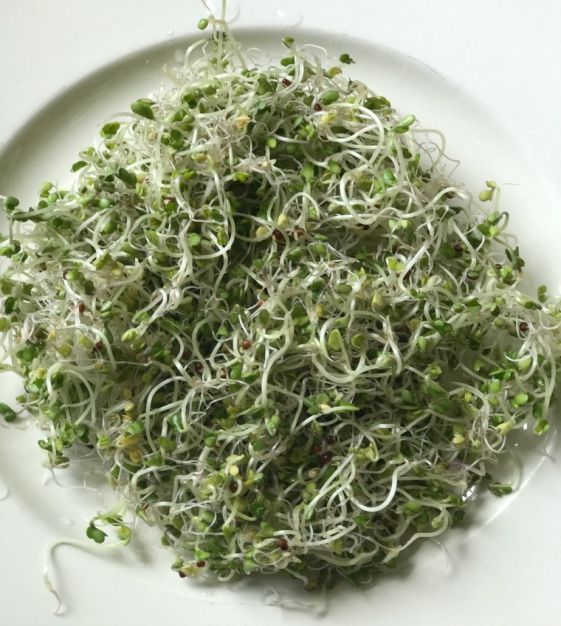Back to Top
Broccoli Sprouting Seed
Days to harvest: 4 to 6. Broccoli sprouts are the healthiest sprouts you can eat! They contain an unusually high concentration of Sulforaphane, a potent anti-cancer antioxidant found in Cruciferous vegetables, and taste wonderful! In a 4 ounce resealable packet. (OP.)
One packet of about 35,000 seeds
One packet of about 35,000 seeds
- Buy 10 for $7.60 each and save 10%
- Buy 50 for $6.35 each and save 25%
- Information
- Gardening Tips
Sprouts are tasty and good for us: packed with vitamins A, C and E, iron, potassium and amino acids as well as being the best ultra-local (your home) supply of off-season greens. Wispy, delicate Alfalfa Sprouts have a mild, slightly nutty flavor, adding a fresh green crunch to salads and sandwiches. (You must try Manfred’s Popeye & Olive Oil Sandwich.) A millennial pantry staple in Asia, Mung Bean Sprouts have a crunchy heft that is essential in all kinds of astounding recipes, from stir-fries and spring rolls to soups and side dishes. There are commercial sprouters available, but the old jar method works just fine. Fit mason jars with a screen for rinsing and draining sprouts or simply use cheese cloth stretched and held in place over the jar mouth with an elastic. The process of seed sprouting is easy. And it goes like this: Rinse. Soak. Drain. Rinse. Soak. Drain. Repeat. Detailed growing instructions are posted HERE and come with every order. Measure out enough seed to cover the bottom of the jar. Clean, cull and rinse seeds with tepid water before soaking. After soaking, drain out the water: the seed should be damp but not wet. Put the jar out of direct sunlight (it could cook the seeds). Every 8-12 hours, add enough water to cover the seeds then drain the water out, leaving the seeds damp but not wet. Provide good air circulation and a consistent 70°F for optimum sprouting (cooler temps retard sprouting and warmer temps push too hard). Prior to harvest, give the Sprouts a little light so that they can green-up. Give a good, thorough final rinsing to remove any remaining hulls. Drain well prior to refrigeration. Use fresh for up to a week or two. Interested in sprouting more types of seed? You can also use the seed of Arugula, Black Turtle Beans, Broccoli, Onions, Peas, Radishes and Watercress for more zesty sproutings. These flavorful, tangy Sprouts are an amazing addition to baby leaf salads and as an haute cuisine garnish strewn atop special main dishes. You can get so creative with Sprouts~a secret ingredient to mystify and fascinate your dinner guests.
Average seed life: 3 years.
Average seed life: 3 years.
Sprouts are tasty and good for us: packed with vitamins A, C and E, iron, potassium and amino acids as well as being the best ultra-local (your home) supply of off-season greens. Wispy, delicate Alfalfa Sprouts have a mild, slightly nutty flavor, adding a fresh green crunch to salads and sandwiches. (You must try Manfred’s Popeye & Olive Oil Sandwich.) A millennial pantry staple in Asia, Mung Bean Sprouts have a crunchy heft that is essential in all kinds of astounding recipes, from stir-fries and spring rolls to soups and side dishes. There are commercial sprouters available, but the old jar method works just fine. Fit mason jars with a screen for rinsing and draining sprouts or simply use cheese cloth stretched and held in place over the jar mouth with an elastic. The process of seed sprouting is easy. And it goes like this: Rinse. Soak. Drain. Rinse. Soak. Drain. Repeat. Detailed growing instructions are posted HERE and come with every order. Measure out enough seed to cover the bottom of the jar. Clean, cull and rinse seeds with tepid water before soaking. After soaking, drain out the water: the seed should be damp but not wet. Put the jar out of direct sunlight (it could cook the seeds). Every 8-12 hours, add enough water to cover the seeds then drain the water out, leaving the seeds damp but not wet. Provide good air circulation and a consistent 70°F for optimum sprouting (cooler temps retard sprouting and warmer temps push too hard). Prior to harvest, give the Sprouts a little light so that they can green-up. Give a good, thorough final rinsing to remove any remaining hulls. Drain well prior to refrigeration. Use fresh for up to a week or two. Interested in sprouting more types of seed? You can also use the seed of Arugula, Black Turtle Beans, Broccoli, Onions, Peas, Radishes and Watercress for more zesty sproutings. These flavorful, tangy Sprouts are an amazing addition to baby leaf salads and as an haute cuisine garnish strewn atop special main dishes. You can get so creative with Sprouts~a secret ingredient to mystify and fascinate your dinner guests.
Average seed life: 3 years.
Average seed life: 3 years.




